TOYOTA GR YARIS 2022 Owners Manual
Manufacturer: TOYOTA, Model Year: 2022, Model line: GR YARIS, Model: TOYOTA GR YARIS 2022Pages: 470, PDF Size: 113.17 MB
Page 161 of 470
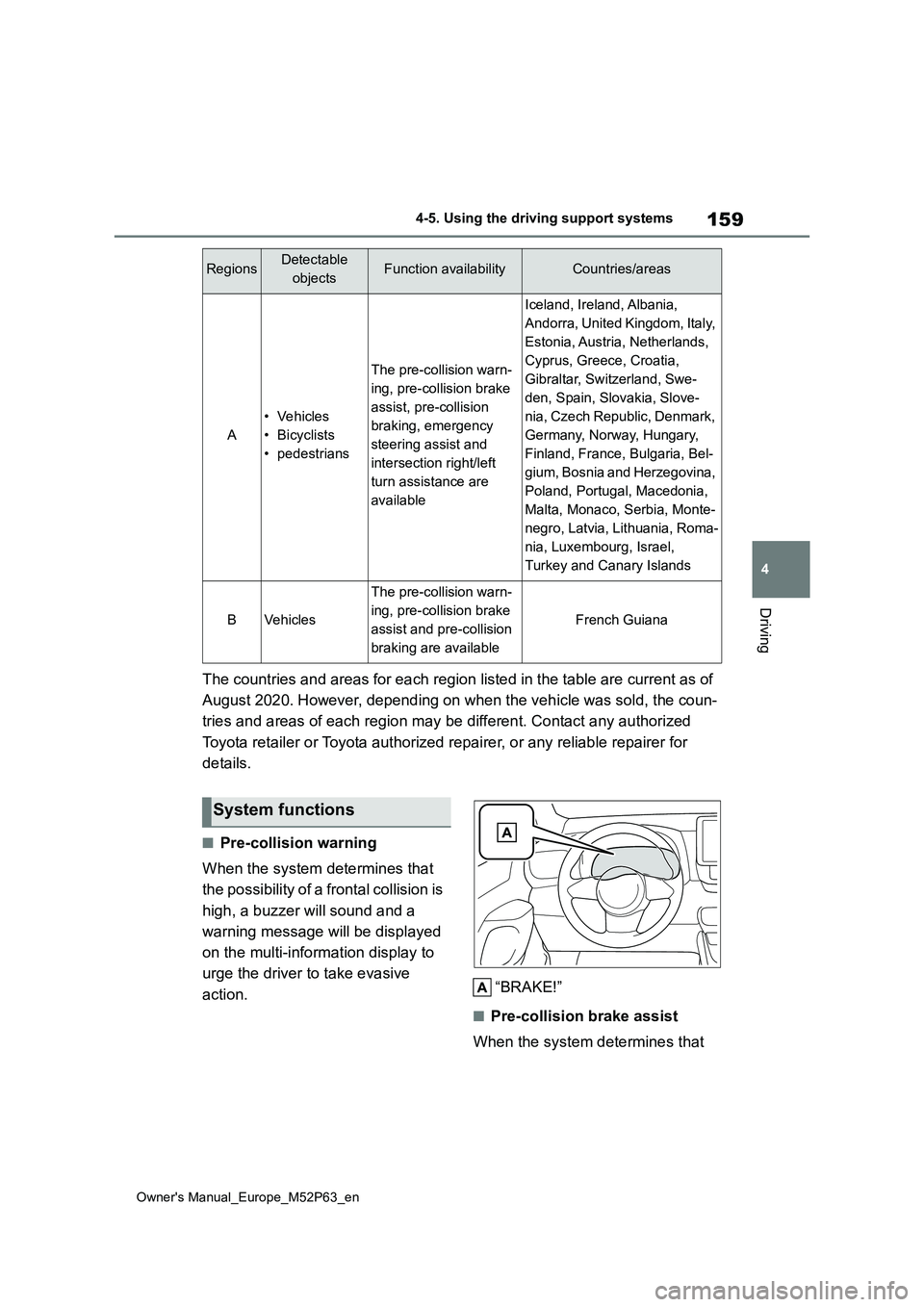
159
4
Owner's Manual_Europe_M52P63_en
4-5. Using the driving support systems
Driving
The countries and areas for each region listed in the table are current as of
August 2020. However, depending on when the vehicle was sold, t he coun-
tries and areas of each region may be different. Contact any au thorized
Toyota retailer or Toyota authorized repairer, or any reliable repairer for
details.
■Pre-collision warning
When the system determines that
the possibility of a frontal collision is
high, a buzzer will sound and a
warning message will be displayed
on the multi-information display to
urge the driver to take evasive
action. “BRAKE!”
■Pre-collision brake assist
When the system determines that
RegionsDetectable
objectsFunction availabilityCountries/areas
A
• Vehicles
• Bicyclists
• pedestrians
The pre-collision warn-
ing, pre-collision brake
assist, pre-collision
braking, emergency
steering assist and
intersection right/left
turn assistance are
available
Iceland, Ireland, Albania,
Andorra, United Kingdom, Italy,
Estonia, Austria, Netherlands,
Cyprus, Greece, Croatia,
Gibraltar, Switzerland, Swe-
den, Spain, Slovakia, Slove-
nia, Czech Republic, Denmark,
Germany, Norway, Hungary,
Finland, France, Bulgaria, Bel-
gium, Bosnia and Herzegovina,
Poland, Portugal, Macedonia,
Malta, Monaco, Serbia, Monte-
negro, Latvia, Lithuania, Roma-
nia, Luxembourg, Israel,
Turkey and Canary Islands
BVehicles
The pre-collision warn-
ing, pre-collision brake
assist and pre-collision
braking are available
French Guiana
System functions
Page 162 of 470
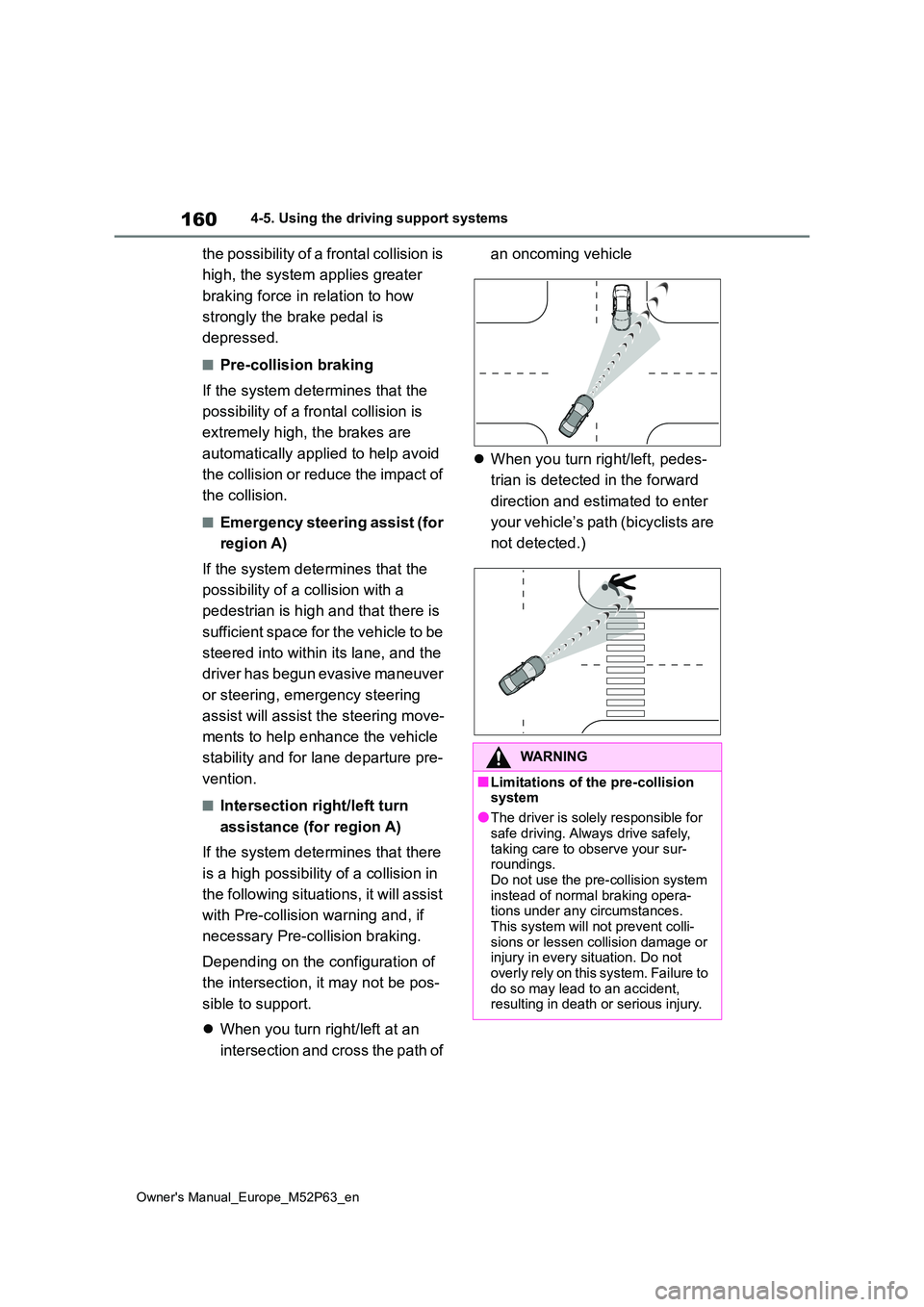
160
Owner's Manual_Europe_M52P63_en
4-5. Using the driving support systems
the possibility of a frontal collision is
high, the system applies greater
braking force in relation to how
strongly the brake pedal is
depressed.
■Pre-collision braking
If the system determines that the
possibility of a frontal collision is
extremely high, the brakes are
automatically applied to help avoid
the collision or reduce the impact of
the collision.
■Emergency steering assist (for
region A)
If the system determines that the
possibility of a collision with a
pedestrian is high and that there is
sufficient space for the vehicle to be
steered into within its lane, and the
driver has begun evasive maneuver
or steering, emergency steering
assist will assist the steering move-
ments to help enhance the vehicle
stability and for lane departure pre-
vention.
■Intersection right/left turn
assistance (for region A)
If the system determines that there
is a high possibility of a collision in
the following situations, it will assist
with Pre-collision warning and, if
necessary Pre-collision braking.
Depending on the configuration of
the intersection, it may not be pos-
sible to support.
When you turn right/left at an
intersection and cross the path of
an oncoming vehicle
When you turn right/left, pedes-
trian is detected in the forward
direction and estimated to enter
your vehicle’s path (bicyclists are
not detected.)
WARNING
■Limitations of the pre-collision system
●The driver is solely responsible for
safe driving. Always drive safely, taking care to observe your sur-roundings.
Do not use the pre-collision system instead of normal braking opera-tions under any circumstances.
This system will not prevent colli- sions or lessen collision damage or injury in every situation. Do not
overly rely on this system. Failure to do so may lead to an accident, resulting in death or serious injury.
Page 163 of 470

161
4
Owner's Manual_Europe_M52P63_en
4-5. Using the driving support systems
Driving
WARNING
●Although this system is designed to he l p a vo id a c ol li s io n o r he lp r ed u ce
the impact of the collision, its effec- tiveness may change according to various conditions, therefore the
system may not always be able to achieve the same level of perfor-mance.
Read the following conditions care- fully. Do not overly rely on this sys-tem and always drive carefully.
• Conditions under which the system may operate even if there is no pos-
sibility of a collision: P. 1 6 5
• Conditions under which the system
may not operate properly: P. 1 6 7
●Do not attempt to test the operation
of the pre-collision system yourself. Depending on the objects used for testing (dummies, cardboard
objects imitating detectable objects, etc.), the system may not operate properly, possibly leading to an
accident.
■Pre-collision braking
●When the pre-collision braking function is operating, a large amount of braking force will be
applied.
●If the vehicle is stopped by the
operation of the pre-collision brak- ing function, the pre-collision brak-ing function operation will be
canceled after approximately 2 sec- onds. Depress the brake pedal as necessary.
●The pre-collision braking function may not operate if certain opera-tions are performed by the driver. If
the accelerator pedal is being depressed strongly or the steering wheel is being turned, the system
may determine that the driver is tak- ing evasive action and possibly pre-vent the pre-collision braking
function from operating.
●In some situations, while the pre-
collision braking function is operat- ing, operation of the function may be canceled if the accelerator pedal
is depressed strongly or the steer- ing wheel is turned and the system determines that the driver is taking
evasive action.
●If the brake pedal is being
depressed, the system may deter- mine that the driver is taking eva-sive action and possibly delay the
operation timing of the pre-collision braking function.
■Emergency steering assist (for region A)
●As emergency steering assist oper-
ation will be canceled when the sys- tem determines that lane departure prevention function has been com-
pleted.
●Emergency steering assist may not
operate or may be cancel in the fol- lowing cases as the system may determine the driver is taking
actions.
• If the accelerator pedal is being
depressed strongly, the steering wheel is being operated sharply, the brake pedal is being depressed
or the turn signal lever is being operated. In this case, the system may determine that the driver is tak-
ing evasive action and the emer- gency steering assist may not operate.
Page 164 of 470
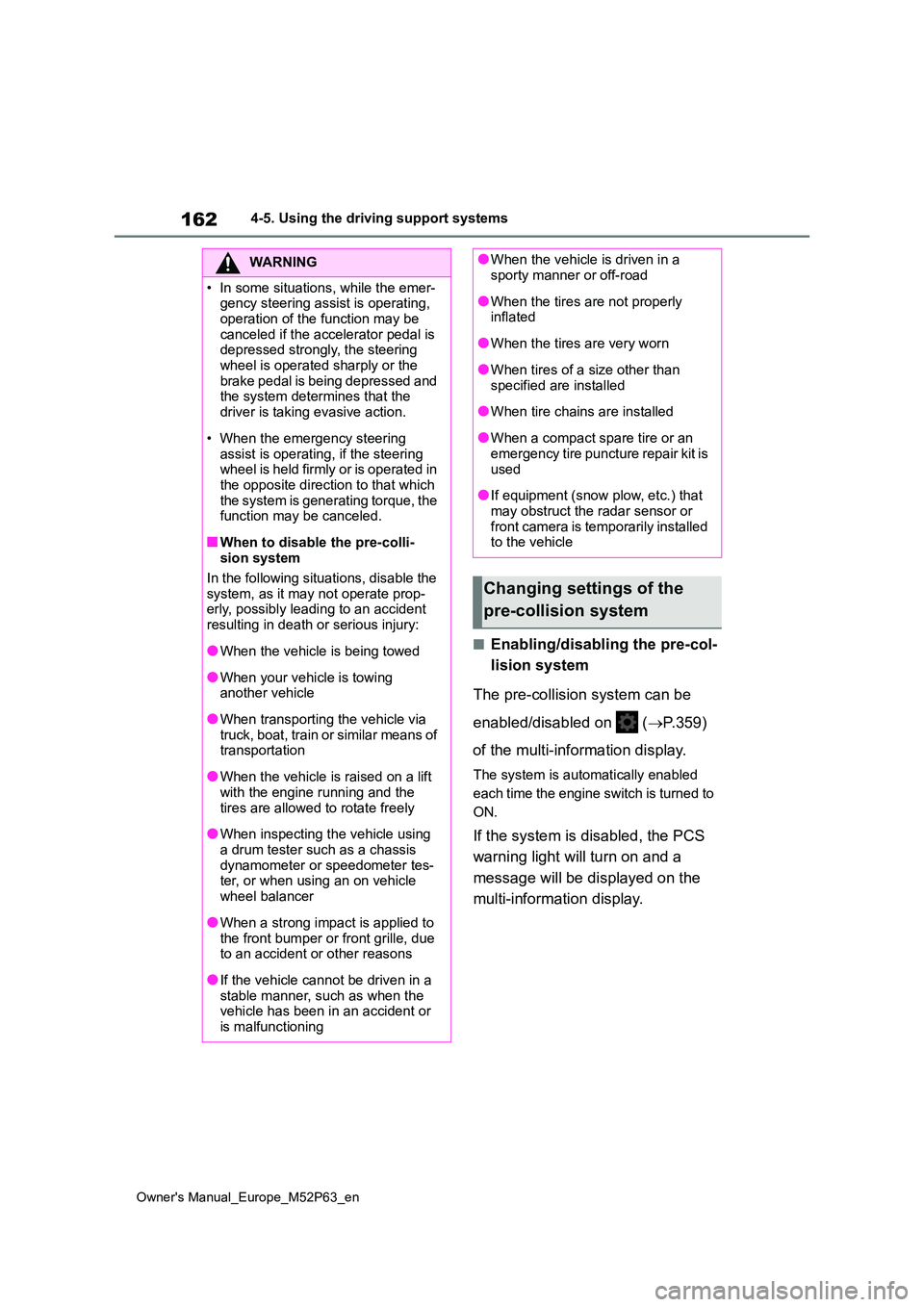
162
Owner's Manual_Europe_M52P63_en
4-5. Using the driving support systems
■Enabling/disabling the pre-col-
lision system
The pre-collision system can be
enabled/disabled on ( P.359)
of the multi-information display.
The system is automatically enabled
each time the engine switch is turned to
ON.
If the system is disabled, the PCS
warning light will turn on and a
message will be displayed on the
multi-information display.
WARNING
�
Page 165 of 470
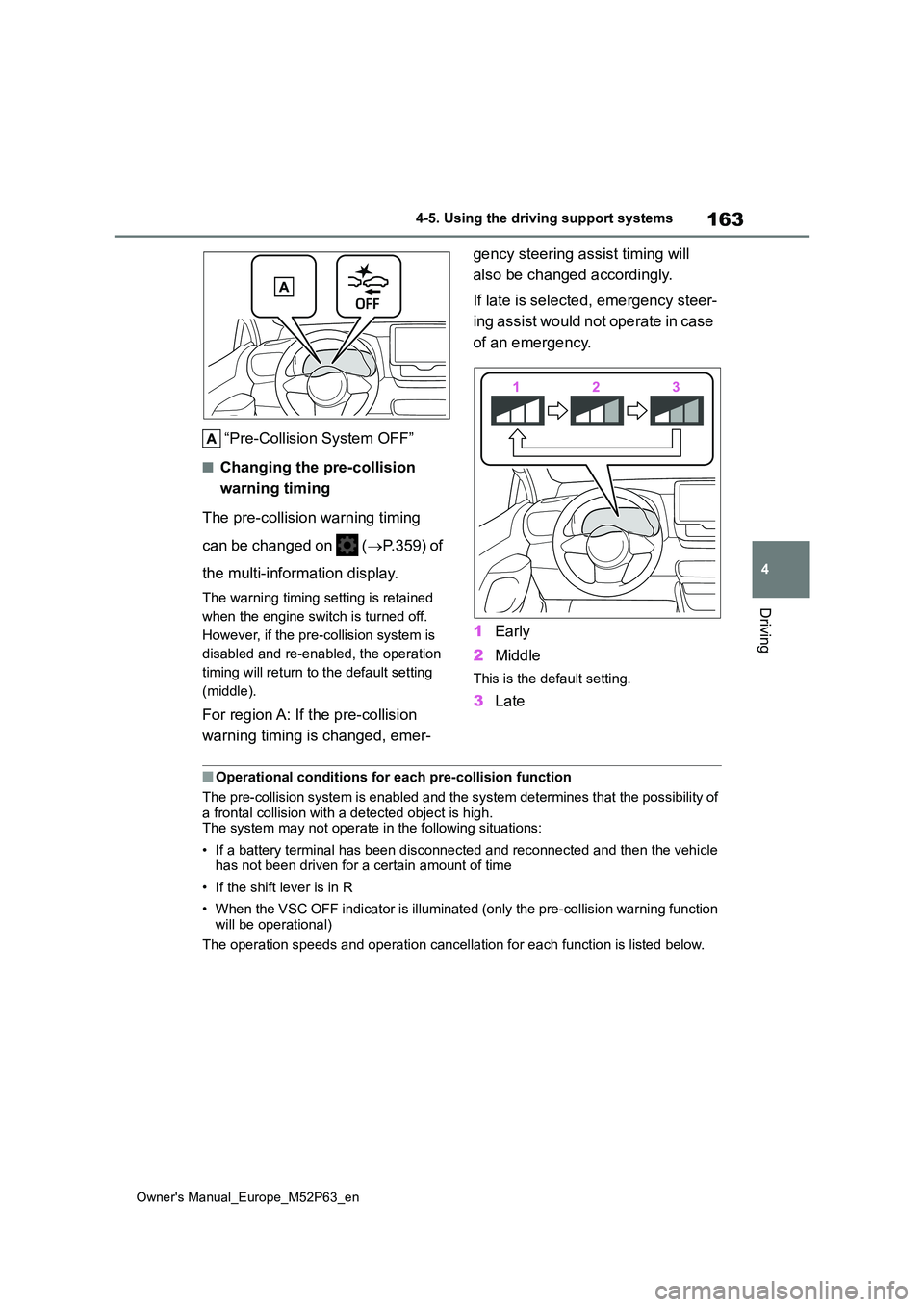
163
4
Owner's Manual_Europe_M52P63_en
4-5. Using the driving support systems
Driving
“Pre-Collision System OFF”
■Changing the pre-collision
warning timing
The pre-collision warning timing
can be changed on ( P.359) of
the multi-information display.
The warning timing setting is retained
when the engine switch is turned off.
However, if the pre-collision system is
disabled and re-enabled, the operation
timing will return to the default setting
(middle).
For region A: If the pre-collision
warning timing is changed, emer-
gency steering assist timing will
also be changed accordingly.
If late is selected, emergency steer-
ing assist would not operate in case
of an emergency.
1 Early
2 Middle
This is the default setting.
3Late
■Operational conditions for each pre-collision function
The pre-collision system is enabled and the system determines t hat the possibility of a frontal collision with a detected object is high.The system may not operate in the following situations:
• If a battery terminal has been disconnected and reconnected an d then the vehicle has not been driven for a certain amount of time
• If the shift lever is in R
• When the VSC OFF indicator is illuminated (only the pre-collis ion warning function will be operational)
The operation speeds and operation cancellation for each functi on is listed below.
Page 166 of 470
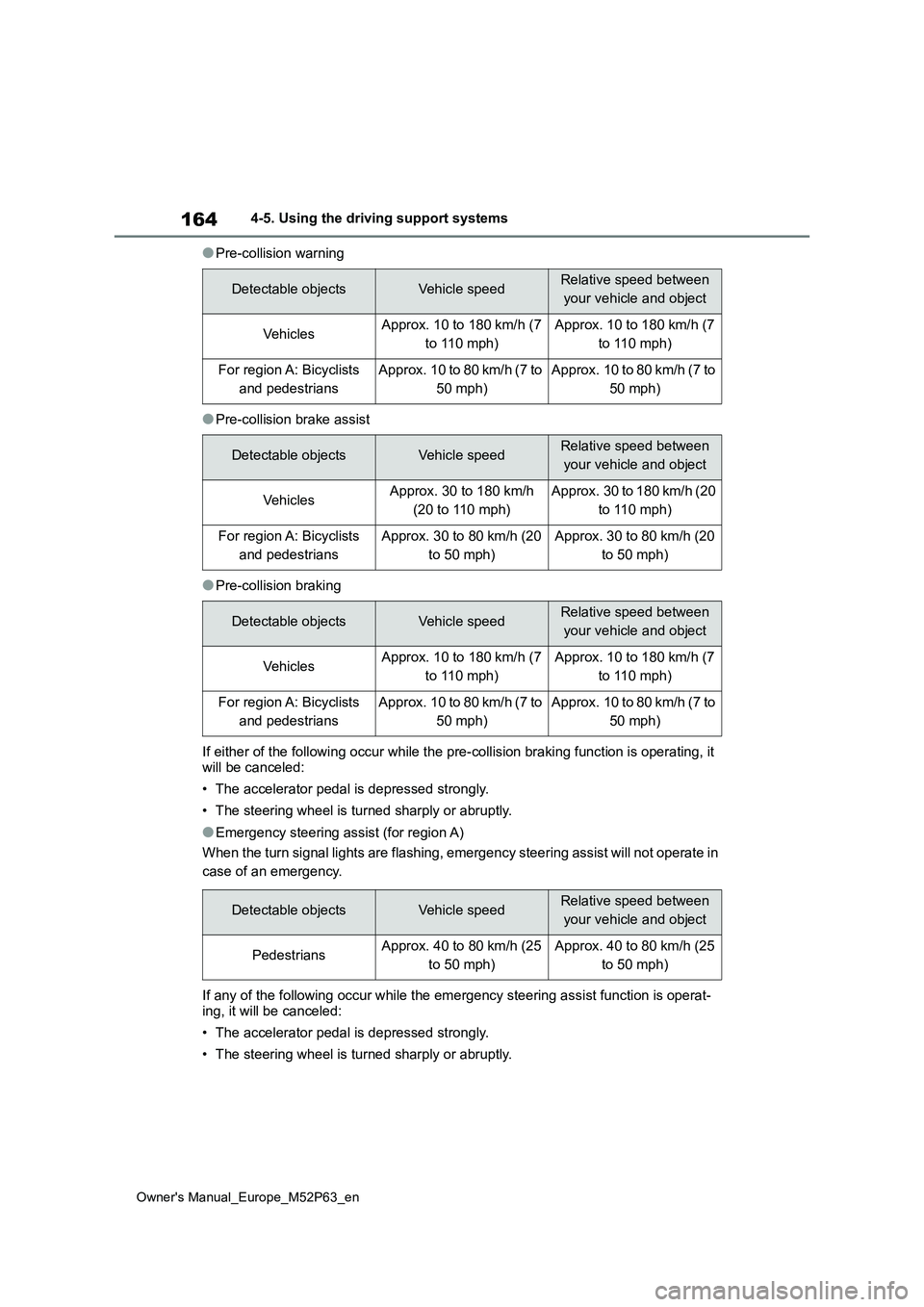
164
Owner's Manual_Europe_M52P63_en
4-5. Using the driving support systems
●Pre-collision warning
●Pre-collision brake assist
●Pre-collision braking
If either of the following occur while the pre-collision brakin g function is operating, it
will be canceled:
• The accelerator pedal is depressed strongly.
• The steering wheel is turned sharply or abruptly.
●Emergency steering assist (for region A)
When the turn signal lights are flashing, emergency steering as sist will not operate in
case of an emergency.
If any of the following occur while the emergency steering assi st function is operat- ing, it will be canceled:
• The accelerator pedal is depressed strongly.
• The steering wheel is turned sharply or abruptly.
Detectable objectsVehicle speedRelative speed between
your vehicle and object
Ve hi cl e sApprox. 10 to 180 km/h (7
to 110 mph)
Approx. 10 to 180 km/h (7
to 110 mph)
For region A: Bicyclists
and pedestrians
Approx. 10 to 80 km/h (7 to
50 mph)
Approx. 10 to 80 km/h (7 to
50 mph)
Detectable objectsVehicle speedRelative speed between
your vehicle and object
Ve hi cl e sApprox. 30 to 180 km/h
(20 to 110 mph)
Approx. 30 to 180 km/h (20
to 110 mph)
For region A: Bicyclists
and pedestrians
Approx. 30 to 80 km/h (20
to 50 mph)
Approx. 30 to 80 km/h (20
to 50 mph)
Detectable objectsVehicle speedRelative speed between
your vehicle and object
Ve hi cl e sApprox. 10 to 180 km/h (7
to 110 mph)
Approx. 10 to 180 km/h (7
to 110 mph)
For region A: Bicyclists
and pedestrians
Approx. 10 to 80 km/h (7 to
50 mph)
Approx. 10 to 80 km/h (7 to
50 mph)
Detectable objectsVehicle speedRelative speed between
your vehicle and object
PedestriansApprox. 40 to 80 km/h (25
to 50 mph)
Approx. 40 to 80 km/h (25
to 50 mph)
Page 167 of 470
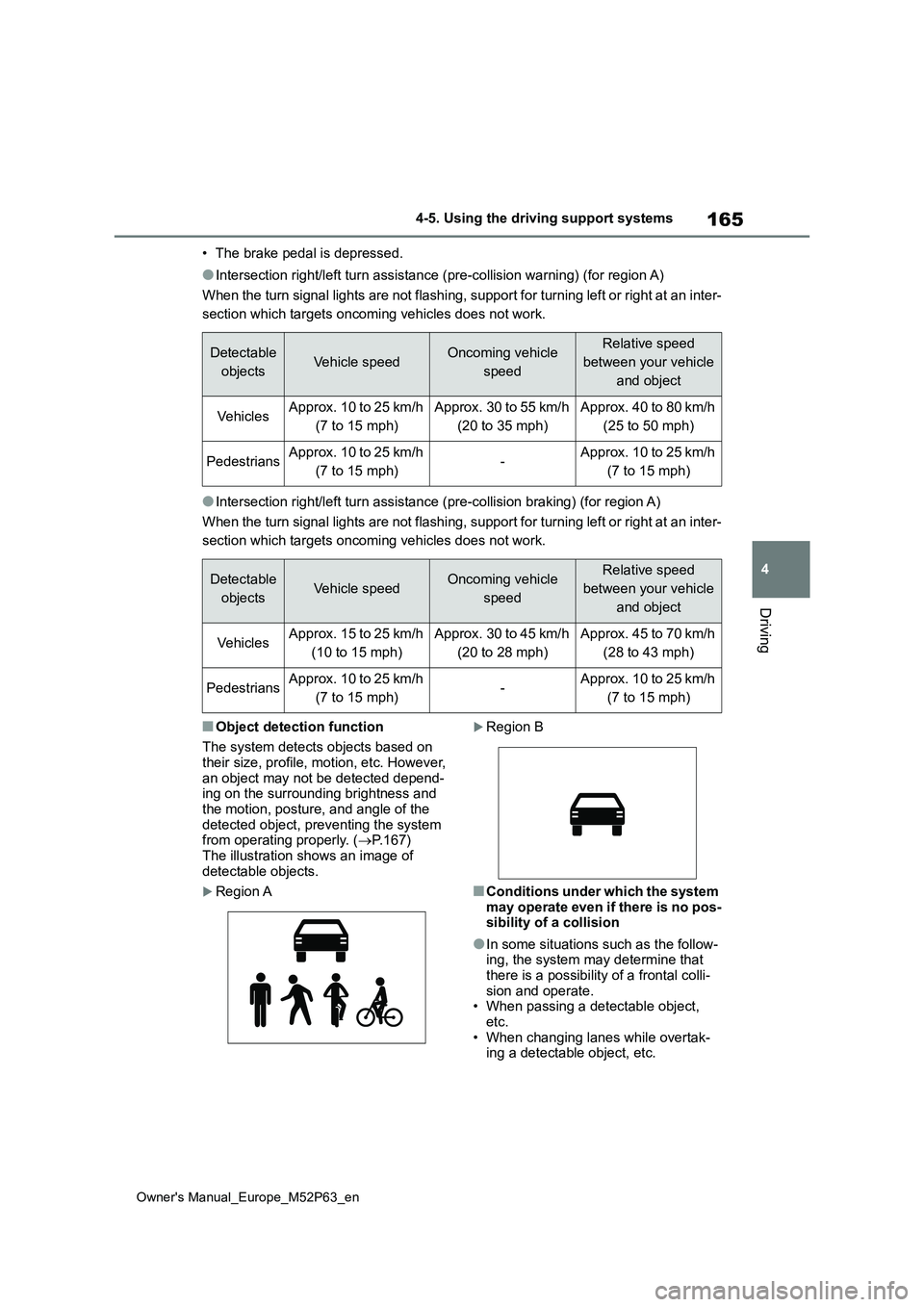
165
4
Owner's Manual_Europe_M52P63_en
4-5. Using the driving support systems
Driving
• The brake pedal is depressed.
●Intersection right/left turn assistance (pre-collision warning) (for region A)
When the turn signal lights are not flashing, support for turni ng left or right at an inter-
section which targets oncoming vehicles does not work.
●Intersection right/left turn assistance (pre-collision braking) (for region A)
When the turn signal lights are not flashing, support for turni ng left or right at an inter-
section which targets oncoming vehicles does not work.
■Object detection function
The system detects objects based on
their size, profile, motion, etc. However, an object may not be detected depend-ing on the surrounding brightness and
the motion, posture, and angle of the detected object, preventing the system from operating properly. ( P.167)
The illustration shows an image of detectable objects.
Region A
Region B
■Conditions under which the system may operate even if there is no pos-sibility of a collision
●In some situations such as the follow-ing, the system may determine that
there is a possibility of a frontal colli- sion and operate.• When passing a detectable object,
etc. • When changing lanes while overtak-ing a detectable object, etc.
Detectable
objectsVehicle speedOncoming vehicle
speed
Relative speed
between your vehicle
and object
Ve hi cl e sApprox. 10 to 25 km/h
(7 to 15 mph)
Approx. 30 to 55 km/h
(20 to 35 mph)
Approx. 40 to 80 km/h
(25 to 50 mph)
PedestriansApprox. 10 to 25 km/h
(7 to 15 mph)-Approx. 10 to 25 km/h
(7 to 15 mph)
Detectable
objectsVehicle speedOncoming vehicle
speed
Relative speed
between your vehicle
and object
Ve hi cl e sApprox. 15 to 25 km/h
(10 to 15 mph)
Approx. 30 to 45 km/h
(20 to 28 mph)
Approx. 45 to 70 km/h
(28 to 43 mph)
PedestriansApprox. 10 to 25 km/h
(7 to 15 mph)-Approx. 10 to 25 km/h
(7 to 15 mph)
Page 168 of 470

166
Owner's Manual_Europe_M52P63_en
4-5. Using the driving support systems
• When approaching a detectable
object in an adjacent lane or on the roadside, such as when changing the course of travel or driving on a wind-
ing road
• When rapidly closing on a detectable
object, etc. • When approaching objects on the roadside, such as detectable objects,
guardrails, utility poles, trees, or walls • When there is a detectable object or other object by the roadside at the
entrance of a curve
• When there are patterns or paint in
front of your vehicle that may be mis- taken for a detectable object• When the front of your vehicle is hit by
water, snow, dust, etc. • When overtaking a detectable object that is changing lanes or making a
right/left turn
• When passing a detectable object in
an oncoming lane that is stopped to make a right/left turn
• When a detectable object approaches
very close and then stops before entering the path of your vehicle• If the front of your vehicle is raised or
lowered, such as when on an uneven or undulating road surface• When driving on a road surrounded by
a structure, such as in a tunnel or on an iron bridge• When there is a metal object (man-
hole cover, steel plate, etc.), steps, or a protrusion in front of your vehicle• When passing under an object (road
sign, billboard, etc.)
• When approaching an electric toll gate
barrier, parking area barrier, or other barrier that opens and closes• When using an automatic car wash
• When driving through or under objects that may contact your vehicle, such as thick grass, tree branches, or a ban-
ner
• When driving through steam or smoke
• When driving near an object that
Page 169 of 470

167
4
Owner's Manual_Europe_M52P63_en
4-5. Using the driving support systems
Driving
reflects radio waves, such as a large
truck or guardrail • When driving near a TV tower, broad-casting station, electric power plant,
radar equipped vehicles, etc., or other location where strong radio waves or electrical noise may be present
• When there are many things which can reflect the radio waves of the radar in the vicinity (tunnels, truss
bridges, gravel roads, snow covered road that have tracks, etc.)• For region A: While making a right/left
turn, when an oncoming vehicle or a crossing pedestrian has already exited the path of your vehicle
• For region A: While making a right/left turn, closely in front of an oncoming vehicle or a crossing pedestrian.
• For region A: While making a right/left turn, when an oncoming vehicle or a crossing pedestrian stops before
entering the path of your vehicle • For region A: While making a right/left turn, when an oncoming vehicle turns
right/left in front of your vehicle
• For region A: While steering into the
direction of oncoming traffic
■Situations in which the system may not operate properly
●In some situations such as the follow-ing, an object may not be detected by the radar sensor and front camera,
preventing the system from operating properly:• When a detectable object is
approaching your vehicle • When your vehicle or a detectable object is wobbling
• If a detectable object makes an abrupt maneuver (such as sudden swerving, acceleration or deceleration)
• When your vehicle approaches a
detectable object rapidly • When a detectable object is not directly in front of your vehicle
• When a detectable object is near a wall, fence, guardrail, manhole cover,
vehicle, steel plate on the road, etc. • When a detectable object is under a structure
• When part of a detectable object is hidden by an object, such as large baggage, an umbrella, or guardrail
• When there are many things which can reflect the radio waves of the radar in the vicinity (tunnels, truss
bridges, gravel roads, snow covered road that have tracks, etc.)• When there is an effect on the radio
waves to the radar that is installed on another vehicle• When multiple detectable objects are
close together • If the sun or other light is shining directly on a detectable object
• When a detectable object is a shade of white and looks extremely bright• When a detectable object appears to
be nearly the same color or brightness as its surroundings• If a detectable object cuts or suddenly
emerges in front of your vehicle • When the front of your vehicle is hit by water, snow, dust, etc.
• When a very bright light ahead, such as the sun or the headlights of oncom-ing traffic, shines directly into the front
camera • When approaching the side or front of a vehicle ahead
• If a vehicle ahead is a motorcycle • If a vehicle ahead is narrow, such as a personal mobility vehicle
• If a preceding vehicle has a small rear
Page 170 of 470
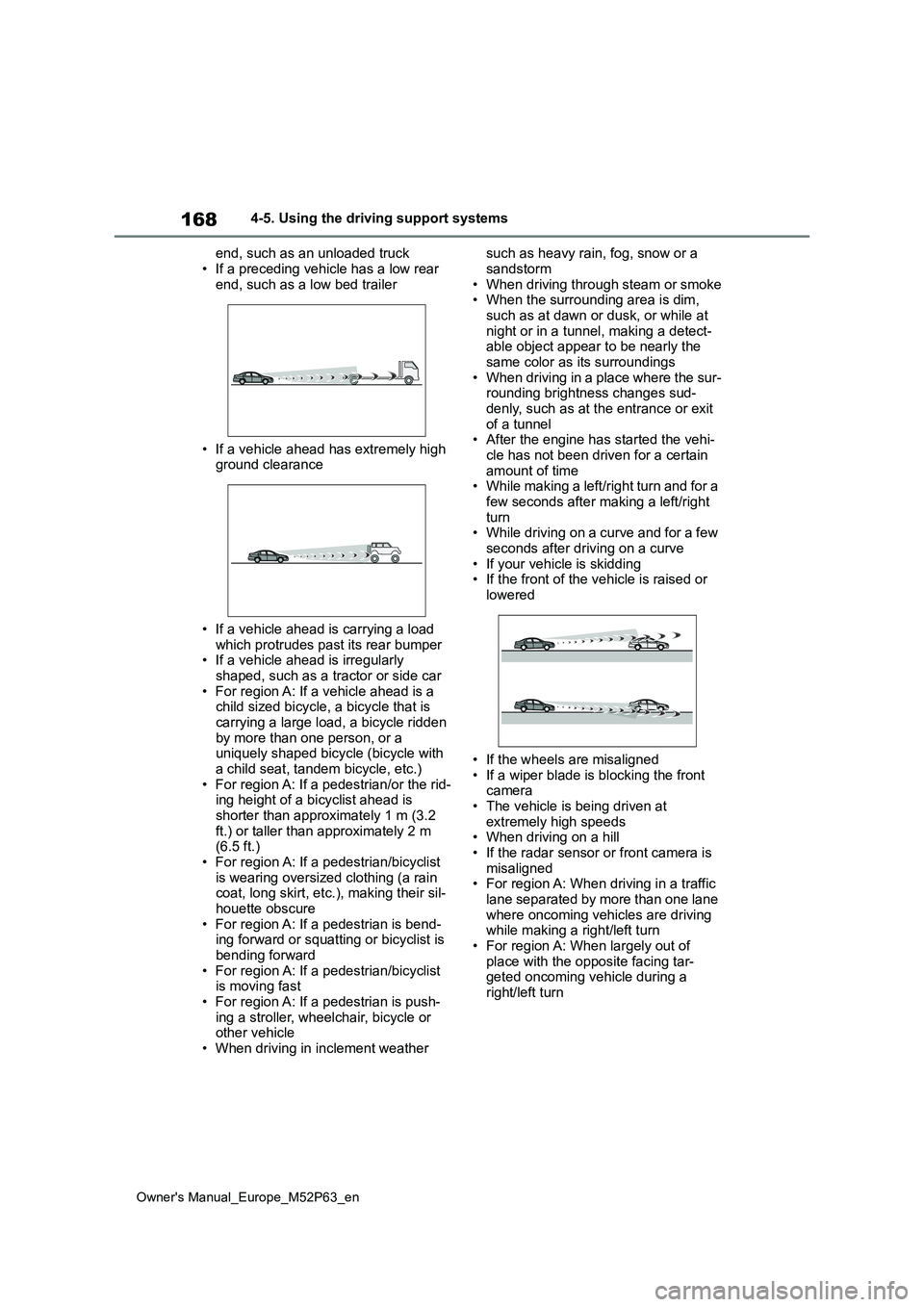
168
Owner's Manual_Europe_M52P63_en
4-5. Using the driving support systems
end, such as an unloaded truck
• If a preceding vehicle has a low rear end, such as a low bed trailer
• If a vehicle ahead has extremely high ground clearance
• If a vehicle ahead is carrying a load which protrudes past its rear bumper• If a vehicle ahead is irregularly
shaped, such as a tractor or side car • For region A: If a vehicle ahead is a child sized bicycle, a bicycle that is
carrying a large load, a bicycle ridden by more than one person, or a uniquely shaped bicycle (bicycle with
a child seat, tandem bicycle, etc.) • For region A: If a pedestrian/or the rid-ing height of a bicyclist ahead is
shorter than approximately 1 m (3.2 ft.) or taller than approximately 2 m (6.5 ft.)
• For region A: If a pedestrian/bicyclist is wearing oversized clothing (a rain coat, long skirt, etc.), making their sil-
houette obscure • For region A: If a pedestrian is bend-ing forward or squatting or bicyclist is
bending forward • For region A: If a pedestrian/bicyclist is moving fast
• For region A: If a pedestrian is push- ing a stroller, wheelchair, bicycle or other vehicle
• When driving in inclement weather
such as heavy rain, fog, snow or a
sandstorm • When driving through steam or smoke• When the surrounding area is dim,
such as at dawn or dusk, or while at night or in a tunnel, making a detect-able object appear to be nearly the
same color as its surroundings • When driving in a place where the sur-rounding brightness changes sud-
denly, such as at the entrance or exit of a tunnel• After the engine has started the vehi-
cle has not been driven for a certain amount of time• While making a left/right turn and for a
few seconds after making a left/right turn• While driving on a curve and for a few
seconds after driving on a curve • If your vehicle is skidding• If the front of the vehicle is raised or
lowered
• If the wheels are misaligned
• If a wiper blade is blocking the front camera• The vehicle is being driven at
extremely high speeds • When driving on a hill• If the radar sensor or front camera is
misaligned • For region A: When driving in a traffic lane separated by more than one lane
where oncoming vehicles are driving while making a right/left turn• For region A: When largely out of
place with the opposite facing tar- geted oncoming vehicle during a right/left turn